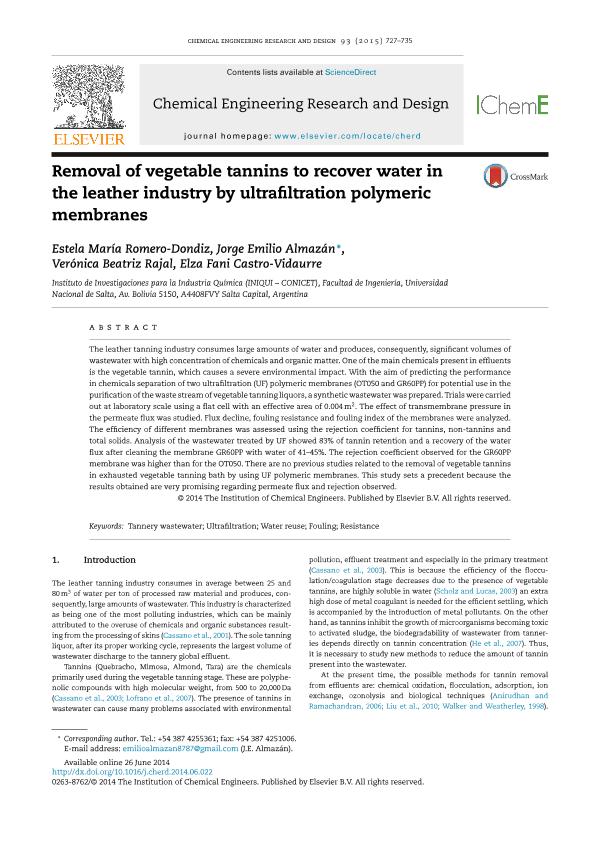Artículo
Removal of vegetable tannins to recover water in the leather industry by ultrafiltration polymeric membranes
Romero Dondiz, Estela María ; Almazán, Jorge Emilio
; Almazán, Jorge Emilio ; Rajal, Verónica Beatriz
; Rajal, Verónica Beatriz ; Castro Vidaurre, Elza Fani
; Castro Vidaurre, Elza Fani
 ; Almazán, Jorge Emilio
; Almazán, Jorge Emilio ; Rajal, Verónica Beatriz
; Rajal, Verónica Beatriz ; Castro Vidaurre, Elza Fani
; Castro Vidaurre, Elza Fani
Fecha de publicación:
01/2015
Editorial:
Institution of Chemical Engineers
Revista:
Chemical Engineering Research & Design
ISSN:
0263-8762
Idioma:
Inglés
Tipo de recurso:
Artículo publicado
Clasificación temática:
Resumen
The leather tanning industry consumes large amounts of water and produces, consequently, significant volumes of wastewater with high concentration of chemicals and organic matter. One of the main chemicals present in effluents is the vegetable tannin, which causes a severe environmental impact. With the aim of predicting the performance in chemicals separation of two ultrafiltration (UF) polymeric membranes (OT050 and GR60PP) for potential use in the purification of the waste stream of vegetable tanning liquors, a synthetic wastewater was prepared. Trials were carried out at laboratory scale using a flat cell with an effective area of 0.004m2. The effect of transmembrane pressure in the permeate flux was studied. Flux decline, fouling resistance and fouling index of the membranes were analyzed. The efficiency of different membranes was assessed using the rejection coefficient for tannins, non-tannins and total solids. Analysis of the wastewater treated by UF showed 83% of tannin retention and a recovery of the water flux after cleaning the membrane GR60PP with water of 41-45%. The rejection coefficient observed for the GR60PP membrane was higher than for the OT050. There are no previous studies related to the removal of vegetable tannins in exhausted vegetable tanning bath by using UF polymeric membranes. This study sets a precedent because the results obtained are very promising regarding permeate flux and rejection observed.
Palabras clave:
Fouling
,
Resistance
,
Tannery Wastewater
,
Ultrafiltration
,
Water Reuse
Archivos asociados
Licencia
Identificadores
Colecciones
Articulos(INIQUI)
Articulos de INST.DE INVEST.PARA LA INDUSTRIA QUIMICA (I)
Articulos de INST.DE INVEST.PARA LA INDUSTRIA QUIMICA (I)
Citación
Romero Dondiz, Estela María; Almazán, Jorge Emilio; Rajal, Verónica Beatriz; Castro Vidaurre, Elza Fani; Removal of vegetable tannins to recover water in the leather industry by ultrafiltration polymeric membranes; Institution of Chemical Engineers; Chemical Engineering Research & Design; 93; 1-2015; 727-735
Compartir
Altmétricas



